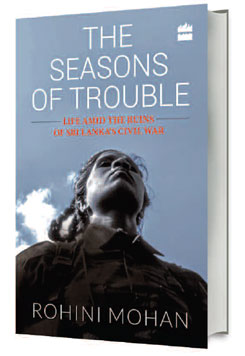 In addition to explicitly chronicling the experiences of women and children in times of armed conflict, The Seasons of Trouble is a testimony to what —and who — is left out of most reportage on war
In addition to explicitly chronicling the experiences of women and children in times of armed conflict, The Seasons of Trouble is a testimony to what —and who — is left out of most reportage on war
Rohini Mohan’s new book, The Seasons of Trouble: Life amid the Ruins of Sri Lanka’s Civil War, is a war story with a difference. For one, you won’t find politicians and starred generals here; just everyday people, especially women and children. In fact, two of the three main characters — Mugil and Indra — are women, and all of them are far removed from the corridors of power, and face struggles specific to the intersections of their class, gender, and ethnic identities. Also, Mohan’s searing account of the three lives caught up in the devastation is based on five years of rigorous reportage, and looks beyond the heroism of wartime survival to reveal the creeping violence of the everyday.
In that, it is a winner. Discriminatory policies against the Tamil, representing 30 per cent of the population, began in the 1950s, accelerated in the 1970s, and culminated with the burning of the Jaffna Tamil library in 1981, and riots in July 1983. When the Sinhalese-dominated Sri Lankan Army “eliminated” the Liberation Tigers of Tamil Eelam (LTTE) by killing its annan Prabakaran in 2009, most people hoped that the small, war-ravaged island nation in the Indian Ocean would rebuild and grow. Instead, the next five years saw the country’s prospects diminished by a government that sought to consolidate its power and limit the rights of its citizens. By recounting the Sri Lankan tragedy through the lives of three real characters within two parallel worlds, Mohan produces a fantastic work of non-fiction presented in a simple yet absorbing fictional style. Gripping, exhilarating, haunting — these words barely scratch the surface of this account of their lives. Though it is non-fiction, The Seasons of Trouble reads like a novel with history of the Sri Lankan civil war interspersed amid the peoples’ stories.
The book begins with the abduction of Sarvanatha Pereira (Sarva in short), a young Tamil, by the Sri Lankan government on suspicions of terrorism. His ability to speak Sinhalese and a surname that enables him to pass for a Sri Lankan, only leads to trouble, since he is suspected to be a spy. This happens in the closing months of 2008, when the Tamil dream of Eelam, an independent homeland in Sri Lanka’s north and east, is crumbling. The government’s army is 200,000-strong, equipped with horrific firepower, and has thrown away any niceties. Tiger ranks are filled with 13-year-old conscripts who try to run away. How could a woman sleep soundly when her son was still in prison? Sarva’s mother, a middle-aged Indra, is the second lead character in the book, whose story traces the bewildering search for her “disappeared” son. Indra, a young mother at the time, was the first to witness the horrible anti-Tamil violence of 1983, which left 3,000 dead and hundreds fleeing the country.
Indra badgers jeering police and officials, most of them from the Sinhala Buddhist majority, until she secures his release, the same way she got Sarva out of the Tiger ranks in Jaffna several years ago. The third character, Mugil, is the rare story of a female combatant attempting to reintegrate into postconflict society. Her story opens in September 2008 with her witnessing the rape/ murder of five teenaged LTTE girls by Lankan soldiers near Kilinochchi, and her furtive escape to her home in Puthukudiyirippu, located in the Vanni, the heart of the Tamil homeland in northern Lanka.
Unlike her husband Divyan and brother Prashant, who surrender to the state, Mugil tries to keep her former identity secret, and teaches herself how to become a mother and a housewife. Despite being a former Tiger, Mugil’s feelings about them are complex and conflicted throughout the book. She tries to shed her Tiger identity and attempts to blend back into civilian society to escape government retribution — a process the government would then use to justify subsequent actions that western commentators saw as direct attacks on civilians.
Sarva has a happy ending so long as he never returns to his homeland; Mugil’s narrative ends with a sinister foreshadowing of further violence in the country, and with the detention of a major character whose ordeal will no doubt be similar to Sarva’s. Of course, there are glimpses of hope. Many of the aid workers helping Sarva and others like him are Sinhalese. Mohan reiterates that there are alternatives, imperfect though they might be. The book reminds us that in every conflict, no side is completely innocent or blameless. Even the victims of Sri Lankan army’s torture are shown to be harbouring irrational animosity and distrust towards Sri Lankan Muslims who speak the same language (Tamil).
Mohan tells us that the LTTE, which had once expelled 72,000 Sri Lankan Muslims from the Northern Province, was no less cruel than the Sri Lankan army, which ultimately defeated it. Poignant descriptions such as these render Mohan’s book such a nuanced account of the struggle. In addition to explicitly chronicling the experiences of women and children in times of armed conflict, The Seasons of Trouble is a testimony to what — and who — is left out of most reportage on war. Mohan subtly reminds us that although winners may be declared, wars are always lost.
